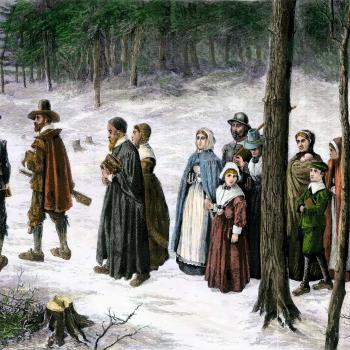What with the news about homo naledi, a new hominin species, it’s probably time to revisit young earth creationist interpretations of such skeletons. Given that young earth creationists start with the Bible and only then look at the scientific evidence, it shouldn’t be surprising that they tend to argue that species like Homo Naledi or Neanderthal are either human or ape. Over the weekend, Answers in Genesis declared homo naledi an ape. Several years ago, Answers in Genesis declared homo floresiensis human.
There’s a reason scientists believe these skeletons are evolutionary ancestors and not regular human beings like ourselves—they differ from our own skeletons in important ways. When young earth creationists write off an early hominin skeleton as simply an extinct ape, they have fewer issues, but when they pass it off as human—as Answers in Genesis did homo floresiensis, popularly referred to as “hobbits” as a result of their small size—they have to account for these differences.
Answers in Genesis has solved this problem by declaring that homo floresiensis, neanderthals, and other related species were simply part of the original genetic diversity of humankind—genetic diversity that somehow began with two individual human beings. See, for example, this article:
Neanderthals buried their dead and may have worn jewelry. Homo erectus seems to have divvied up jobs to prepare food and sailed the high seas. Even with little to go on, we can be fairly certain the Denisovans wore jewelry, and the much-maligned “hobbits” left tools useful for dicing up lunch. All uniquely human traits—traits that show creatures made in the image of God.
In other words, we can be sure that they all descended from Adam through Noah’s family. These certainly aren’t unique species, in the sense of being something “less than modern humans”—they’re just more evidence of beautiful variations in the appearance of individuals in our one unique race. Our relatives may have looked different, but they weren’t bumbling brutes. They had the very human and God-given ability to discover creative solutions in a dangerous, sin-cursed world. And they were all rebels from God, in need of His grace.
Rather than arguing that neanderthals or homo florensiensis are fakes, Answers in Genesis contends that they lived contemporaneously with our ancestors a few thousand years ago and were a reflection of a diversity of humankind that has since ended as these groups died out. They would have you believe that all of these groups are the descendants of two people, Adam and Eve, who were created roughly 6000 years ago. Actually, it’s a bit more narrow and specific than that.
Answers in Genesis holds that Noah and his wife, his three sons and their wives, were the sole human survivors of a worldwide flood in roughly 2348 BC. These eight individuals multiplied quickly enough that in roughly 100 years, they built a city with a tower reaching up toward heaven—the Tower of Babel. After God confused their languages, these descendants of Noah left the city and scattered across the world—and it was at this time that they differentiated into various groups, including neanderthals, homo floresiensis, and the ancestors of modern humans.
Have a look at this, for example:
Genetics has clearly established that Neanderthals and Denisovans were fully human.
Just FYI, this is not true.
Any physical differences should be viewed as nothing more than variations that can occur within the human race descended from Adam and Eve. For a time, these descendants all lived together at the Tower of Babel. Following the post-Babel migration and late into the Ice Age, differing human populations began to appear in the fossil records, such as Neanderthals and Denisovans.
The next questions for creationists are how and why these differences appeared. How is much easier to answer than why!
This is genetically impossible. Yes, modern humans and neanderthals share a common ancestor (around 500,000 years ago), but over time the two populations became distinct as mutations built up, creating differences between their DNA. Answers in Genesis would have you believe that all of these mutations really happened, just much much faster. In other words, Answers in Genesis is positing that human evolution occurred on an unprecedented scale, and that what evolutionary scientists think took 500,000 years took only a few hundred years.
As Jim Foley puts it on the Panda’s Thumb:
There is enough genetic diversity just among modern humans that it is almost impossible for it to have arisen in the last 10,000 years (the young-earth creationist timeframe) at measured mutation rates. For example, the common ancestor of all human mitochondrial DNA sequences (a.k.a ‘mitochondrial Eve’) is estimated to have lived about 200,000 years ago (very approximately; I have also seen an estimate of 140,000 years). If you include Neanderthals in the mix, suddenly you’ve got at least two or three times as much genetic diversity to explain, and only 1/2 to 1/3 as much time for it to happen, because a lot of that diversity had to have happened before the Flood presumably wiped most of it out, say at least 6,000 or 7,000 years ago. And although humans and Neanderthals interbred, they don’t seem to be part of a single large interbreeding population – there was very limited interbreeding, something which seems unlikely in a rapidly expanding population. How do young-earth creationists explain all this? Beats me; I’ve never seen them even try.
Well, they have tried, and contrary to Foley’s assumption that young earth creationists who argue that neanderthals are human would place neanderthals in the two thousand or so years before the flood, they actually place them in the few hundred years after the flood. In the next section, Answers in Genesis discusses some ways you could start with an integrated group of humans at the Tower of Babel—a group made up of fourth cousins, no less—and end up with homo erectus, neanderthals, Denisovans, and homo floresciensis, among others, in a few hundred years.
One possibility is that environmental pressures, such as the Ice Age, “selected” for or against traits within the range of human genetic diversity. (In other words, those that had a particular combination of traits survived in that environment, and others did not.) This may have led to the specific set of features found in Neanderthal people. Many animals following the Flood and during the Ice Age experienced an explosion of variations that allowed them to live and function well in new environments. This could also have been true for humans.
Other possibilities include genetic effects seen mainly in small populations. Small populations would have been typical for a period of time following the breakup of the human population at Babel, as people were separated based on language. The groups that left Babel would have begun with only a few reproducing individuals and not interbred initially with other groups.
A phenomenon known as genetic drift can cause certain genetic variations to become “fixed.” If the population is small, everyone with certain variations can die, without passing them down, and the survivors pass down just one variation to future generations. If no people are moving in or out of the population, characteristics like the pronounced brow ridge or the robust body form in Neanderthals can become dominant.
Another possible impact of the Babel breakup is the founder effect. The founders of each group leaving Babel might simply have differed from one another. Certain traits in one group might have been unknown among the founders of any other group. Those traits would then be unique to each group. Rather than being fixed by genetic drift, the Neanderthal’s pronounced brow ridge or robust body form may have been found among the founders of only one group after they left Babel. Those people may have migrated intentionally to places where they were most comfortable (similar to human behavior today).
Possibility one—selection—posits evolution via natural selection on a literally impossible scale. Possibility two—genetic drift—and possibility three—the founder effect—rely on genetic realities but stretch them way past the breaking point.
There have been plenty of cases over the past several thousand years where a small population has become isolated. Think of the Amish, for example. But while genetic drift and the founder affect to come into play in these situations—the Amish have an unusually high rate of Cohen Syndrome, the Pacific island Pingelap is home to an unusually high rate of colorblindness, and Cândido Godói, Brazil, has an unusually high rate of twins—the genetic differences that result on this timescale are small, unlike the genetic difference between modern humans and neanderthals.
Check out this image from TalkOrigins:
 There is indeed a great deal of diversity within the human population, but that population, even with all of its diversity, is still generally distinct from neanderthals. Scientists now believe that there was some interbreeding between humans and neanderthals, but the very fact that scientists have been able to ascertain that should make it clear that the DNA of the two groups is distinct.
There is indeed a great deal of diversity within the human population, but that population, even with all of its diversity, is still generally distinct from neanderthals. Scientists now believe that there was some interbreeding between humans and neanderthals, but the very fact that scientists have been able to ascertain that should make it clear that the DNA of the two groups is distinct.
I mean for goodness sake, look at their skulls:

Genetics does not work the way Answers in Genesis claims it works, and frankly, if it did, I’m not sure why they’re so keen on insisting that evolution writ large can’t have happened. Young earth creationists would probably insist that the difference is that Adam and Eve’s genes were especially diverse, allowing for an incredible amount of diversity among their children, but genes do not work that way. Genetic diversity is measured in a population, not in an individual.














